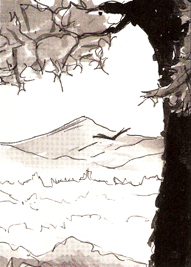|
And, as if to validate the mystic aura of this mountain, over the years, religious groups of various persuasions have assembled on the lower slopes. First, the local Native American people held the mountain in awe. Then, in the mid-nineteenth century, along with vacationers, Christian study groups began to collect in the region, and, more recently, New Age spirits have been assembling around what they see as the powerful energy source of this singular peak. Quite naturally, such a lonely eminence as Monadnock would attract a certain number of devotees. One local man, Larry Davis, has scaled the peak every day of the year for the past seven years; no fewer than 2,500 consecutive ascents. My old friend Dr. Harvey, who is in his eighties, makes a point of climbing the mountain every year with family and friends. Nothing odd about this, of course, except that he makes the climb on January first each year, weather notwithstanding. More to the point, there is a "club" of older gentlemen --- the youngest are in their fifties --- who dub themselves "The Woodshed Gang" and meet on the mountain slopes every Saturday at 11 a.m. for lunch and conversation, no matter what the weather. The patriarch of The Woodshed Gang is a man named Don Henry, who last winter celebrated his eightieth birthday with a celebratory climb. That day the peak was covered with six inches of snow on a layer of black ice, but that did not deter the hardy few. In fact, there were any number of climbers on the slopes that day, many of whom knew the patriarch and his gang. But of all these climbers, and all the visiting mystics, visionaries, and earthlorists, one of the earliest, and, without compare, the most literate, and in some ways, the man who put the Monadnock on the mythopoeic map, was Henry Thoreau. Thoreau first climbed Monadnock in 1844, and he made ten more climbs in his short, uneventful life in spite of the fact that, in his time, a journey to Jaffrey, New Hampshire, from Concord, Massachusetts, was no small matter. On his first trip, he heard the calls of nighthawks passing on the lower slopes, and he associated them, in his transcendental, literary way, with "strains from the music of Chaos. He linked the mountain with the great peaks of history, with Ararat, and the Caucasus, where Prometheus was chained. It was a classic Thoreauvian twist, a universal spin on what is essentially a modest little local height. But then, Thoreau must have known his etymology; a monad, the root of the mountain's name, is an elementary physical or spiritual being that reflects the whole universe. I actually count myself among this loosely associated group of Monadnock mavens. At least once a year, generally in September, and sometimes again in October, I make a point of taking a slow walk up the Dublin Trail on the north side of the mountain. Recently I have come to appreciate the approach to the peak rather than the actual summit. I like the process. I linger on the open vistas on the lower slopes, hike farther along, climb through rocks and clinging firs to the next open space, rest, take in the landscape, and hike on, until finally, at some point about two-thirds of the way up, I see the peak, looming above. The last three or four climbs I haven't even bothered to go all the way to the top. I just like seeing it there, still, silent, heavy, and, from this northern angle, cutting the recumbent sky like the fin of some primordial stone shark. Sanctuary: Journal of the Massachusetts Audubon Society |
